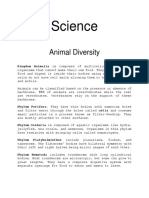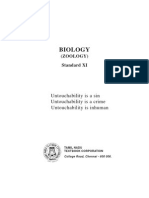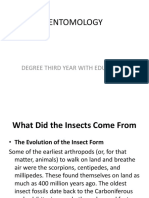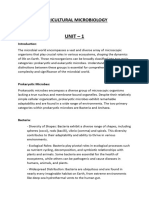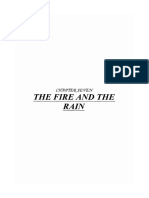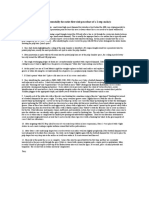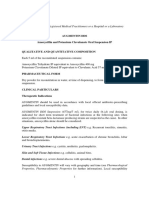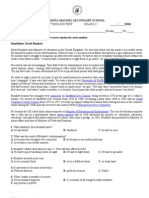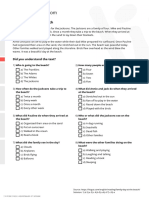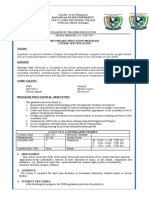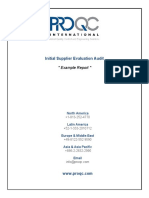100%(1)100% found this document useful (1 vote)
274 viewsZoology (Code No. 03) Paper - I Part - I: Paramaecium, Monocystis, Plasmodium, Trypnosoma and Amoeba
Zoology (Code No. 03) Paper - I Part - I: Paramaecium, Monocystis, Plasmodium, Trypnosoma and Amoeba
Uploaded by
Ram sharmaThis document outlines the structure and content of the zoology curriculum for Paper I and Paper II. Paper I covers non-chordata and chordata structure and biology, ecology, ethology, economic zoology, and laboratory methods. It examines topics such as classification of phyla, protozoa, porifera, coelenterata structure and life cycles, parasitic adaptations, and comparative anatomy of vertebrate systems. Paper II covers cell biology, genetics, evolution, systematics, biochemistry, physiology and embryology, exploring areas like DNA structure and replication, genetics and inheritance, evolution theory, biochemical processes, hormone function, animal physiology systems, and embryonic development in various species.
Copyright:
© All Rights Reserved
Available Formats
Download as PDF, TXT or read online from Scribd
Zoology (Code No. 03) Paper - I Part - I: Paramaecium, Monocystis, Plasmodium, Trypnosoma and Amoeba
Zoology (Code No. 03) Paper - I Part - I: Paramaecium, Monocystis, Plasmodium, Trypnosoma and Amoeba
Uploaded by
Ram sharma100%(1)100% found this document useful (1 vote)
274 views6 pagesThis document outlines the structure and content of the zoology curriculum for Paper I and Paper II. Paper I covers non-chordata and chordata structure and biology, ecology, ethology, economic zoology, and laboratory methods. It examines topics such as classification of phyla, protozoa, porifera, coelenterata structure and life cycles, parasitic adaptations, and comparative anatomy of vertebrate systems. Paper II covers cell biology, genetics, evolution, systematics, biochemistry, physiology and embryology, exploring areas like DNA structure and replication, genetics and inheritance, evolution theory, biochemical processes, hormone function, animal physiology systems, and embryonic development in various species.
Original Description:
zoology syllabus
Original Title
zoology
Copyright
© © All Rights Reserved
Available Formats
PDF, TXT or read online from Scribd
Share this document
Did you find this document useful?
Is this content inappropriate?
This document outlines the structure and content of the zoology curriculum for Paper I and Paper II. Paper I covers non-chordata and chordata structure and biology, ecology, ethology, economic zoology, and laboratory methods. It examines topics such as classification of phyla, protozoa, porifera, coelenterata structure and life cycles, parasitic adaptations, and comparative anatomy of vertebrate systems. Paper II covers cell biology, genetics, evolution, systematics, biochemistry, physiology and embryology, exploring areas like DNA structure and replication, genetics and inheritance, evolution theory, biochemical processes, hormone function, animal physiology systems, and embryonic development in various species.
Copyright:
© All Rights Reserved
Available Formats
Download as PDF, TXT or read online from Scribd
Download as pdf or txt
100%(1)100% found this document useful (1 vote)
274 views6 pagesZoology (Code No. 03) Paper - I Part - I: Paramaecium, Monocystis, Plasmodium, Trypnosoma and Amoeba
Zoology (Code No. 03) Paper - I Part - I: Paramaecium, Monocystis, Plasmodium, Trypnosoma and Amoeba
Uploaded by
Ram sharmaThis document outlines the structure and content of the zoology curriculum for Paper I and Paper II. Paper I covers non-chordata and chordata structure and biology, ecology, ethology, economic zoology, and laboratory methods. It examines topics such as classification of phyla, protozoa, porifera, coelenterata structure and life cycles, parasitic adaptations, and comparative anatomy of vertebrate systems. Paper II covers cell biology, genetics, evolution, systematics, biochemistry, physiology and embryology, exploring areas like DNA structure and replication, genetics and inheritance, evolution theory, biochemical processes, hormone function, animal physiology systems, and embryonic development in various species.
Copyright:
© All Rights Reserved
Available Formats
Download as PDF, TXT or read online from Scribd
Download as pdf or txt
You are on page 1of 6
ZOOLOGY ( CODE NO.
03 )
PAPER - I
PART - I
Structure, general organization and Biology of nonchordata and
chordata, ecology ethology, economic zoology and Laboratory
methods.
1. Non-chordata and chordata
(1) Classfication and relationship of various phyla upto sub-
classes.
(2) Protozoa - Structure , locomotion, nutrition, reproduction; and
life history of Paramaecium, Monocystis, Plasmodium,
Trypnosoma and Amoeba.
(3) Porifera - Stucture, histology, Skeleton, canal system and
reproduction in sycon
(4) Coelenterata - Polymorphism, defensive structures and their
mechanism; coral reefs and their formation; metagenesis;
general features and life history of Obelia and Aurelia.
(5) Platyhelminthes - Parasitic adaptation; general features and
life history of Fasciola and Taenia and their relation to man.
(6) Nemathelminthes - General features, life history and parasitic
adaptation of Ascaris; Nemathelminths in relation to man.
(7) Annelida - Coelom and metamerism; general features and life
history of Neanthes, Pheretima and Hirudinaria.
(8) Arthropoda - External features, organ systems and life histry of
prawn, scorpion and cockroach. Mouth parts in insects
(cockroach, mosquito, housefly, honey bee and butterfly);
metamorphosis in insects and its hormonal regulation; social
organization in insects (termites and honey bees).
(9) Mollusca - Feeding, respiration, locomotion, general features
and life history of Unio & Pila. Torsion and detorsion in
gastropods.
(10) Echinodermata - General features, Feeding, respiration, water
vascular system and locomotion of Asterias.
(11) Protochordata - Origin of chordates; general features and life
history of Herdamania and Branchiostoma.
(12) Pisces - Scales, respiration, locomotion, migration. Structure
and Affinities of Dipnoi.
(13) Amphibia - Parental care, neoteny & paedogenesis.
(14) Reptilia - Poisonous and non poisonous snakes of M.P. - Biting
mechanism of snakes.
(15) Aves - Flight adaptation and migration.
Mammalia - Structural peculiarities and phyllogenetic relation of
profotheria and methatheria
(16) Comparative functional anatomy of following systems of
vertebrates-integument and its derivatives, endoskeleton (limbs
and girdles only), digestive system, respiratory system,
circulatory system (heart and aortic arches only) urino-genital
system, brain and sense organs (eye and ear only).
PART - II
1. Ecology
(1) Biosphere - Biogeochemical cycles, green-houses effect, ozone
layer and its impact; ecological succession.
(2) Population, characteristics, population dynamics, population
stabilization.
(3) Wild life of India its conservations. Biosphere reserves.
Environmental biodegradation; pollution and its impact on
biosphere and its prevention.
2. Ethology
(1) Behaviour - Learning, instinct, habituation, conditioning,
imprinting.
(2) Role of hormones in drive; role of pheromones in alarm
spreading; social behaviour in insects and primates; courtship
(Drosophila, 3-spine stickleback and birds).
Biological clock and circadian rhythms.
3. Economic Zoology
(1) Apiculture, sericulture, lac culture, carp culture, pearl culture,
prawn culture.
(2) Major infectious and communicable diseases (small pox, plague,
malaria, tuberculosis, cholera and AIDS) their vectors,
pathogens and prevention.
Insects and diseases in relation to man.
4. Laboratory techniques
(1) Study of pH meter
(2) Chromatography-(paper and thin layer)
(3) Microtomy
(4) Preparation of fixatives, stains and reagents
(5) Museum keeping & preservation
(6) Skeleton preparation and taxidermy.
ZOOLOGY (CODE NO. 03)
PAPER - II
Cell Biololgy, genetics, evolution, systematics, biochemistry,
physiology and embryology
PART - I
1. Cell Biology
(1) Structure and function of cell and its organelles(nucleus,
plasma membrane, mitochondria, Golgi bodies, endoplasmic
reticulum, ribosomes and Lysosomes), cell division (mitosis and
meiosis), cell cycle.
(2) Watson-Crick model of DNA, replication of DNA,
(3) Protein synthesis.
(4) Cell fusion.
2. Genetics and biotechnology
(1) Genetic code.
(2) Sex chromosomes and sex determination in Drosophilla, and
man.
(3) Mendel's laws of inheritance, recombination, linkage, and
crossing over, multiple alleles, inheritance of blood groups.
(4) Mutations and mutagenesis : radiation and chemical.
(5) Cloning technology, plasmids and cosmids as vectors,
transgenics, transposons, DNA sequence cloning and whole
animal cloning (Principles and methodology).
(6) Regulation and gene expression in pro-and eu-karyotes.
(7) Congenital diseases in man.
(7) DNA finger-printing.
3. Evolution and systematics
(1) Origin of life
(2) Lamarck and his works.
(3) Darwin and his works.
(4) Sources and nature of organic variation.
(5) Natural selection.
(6) Isolation.
(7) Concept of species and sub-species, principles of classification,
zoological nomenclature and international code , cladistics.
(8) Fossils,
(9) Geological eras.
(10) Distribution of animals, zoogeographical realms of the world.
PART - II
1. Biochemistry
(1) Structure and role of carbohydrates, fats, lipids, proteins,
aminoacids, nucleic acids.
(2) Glycolysis and Kre bs cycle, oxidation and reduction, oxidative
phosphorylation; energy conservation and release, ATP, cyclic
AMP-its structure and role.
(3) Hormone and their function.
(4) Enzymes: types and mechanisms of action and co-enzymes.
(5) Immunoglobulin and immunity.
2. Physiology (with reference to mammals)
(1) Composition and constitutents of blood; its coagulation, factors
and mechanism of coagulation; thermo regulation. Blood group
and Rh factor in man.
(2) Oxygen and carbon dioxide transport; haemoglobin :
constitutents and its role in regulation, of gaseous transport.
(3) Nutritive requirements; role of salivary glands, liver, pancreas
and intestinal glands in digestion and absorption.
(4) Excretory products; nephron and regulation of urine formation;
osmoregulation.
(5) Types of muscles, mechanism of contraction of skeletal
muscles.
(6 Neuron, nerve impulse -its conduction and synaptic
transmission; neurotransmitters.
(7) Vision, hearing and olfaction in man.
(8) Mechanism of hormone action.
(9) Physiology of reproduction, role of hormones in reproduction.
3. Embryology
(1) Gametogenesis, fertilization, types of eggs, cleavage, development
up to gastrulation in Branchiostoma, frog and chick,
Metamorphosis in frog, formation and fate of extra embryonic
membranes in chick and mammals. Types and functions of
placenta in mammals;
(2) Paedogenesis and neoteny.
(3) Growth, regeneration and aging.
(4) In vitro fertilization; embryo transfer, cloning.
You might also like
- Animal DiversityDocument3 pagesAnimal DiversityChristian Dave Sanchez50% (2)
- Care Sheet - Fat Tailed GeckoDocument2 pagesCare Sheet - Fat Tailed GeckoJohn GamesbyNo ratings yet
- Invertebrates 2Document11 pagesInvertebrates 2Ruan Victor33% (6)
- 9th International Symposium On Aphids (Abstract Book)Document74 pages9th International Symposium On Aphids (Abstract Book)tayyibnaseemNo ratings yet
- Species Concept, Speciation Evolutionary Thought Before DarwinDocument26 pagesSpecies Concept, Speciation Evolutionary Thought Before DarwinmashedtomatoezedNo ratings yet
- Ellieovalle ScienceresearchpaperDocument4 pagesEllieovalle Scienceresearchpaperapi-252167632No ratings yet
- Indus Valley Civilization (IVC) : John MarshallDocument4 pagesIndus Valley Civilization (IVC) : John MarshallTushar JadhavNo ratings yet
- BryophytaDocument15 pagesBryophytaShah RafiqNo ratings yet
- Bio Zoology 11thDocument247 pagesBio Zoology 11thPradeep ChandarNo ratings yet
- PG TRB Zoology Revision Test Unit IV and VDocument13 pagesPG TRB Zoology Revision Test Unit IV and VRoopa Roopavathy100% (1)
- Project Animal Behaviour and Chronobiology Indrajit GoswamiDocument28 pagesProject Animal Behaviour and Chronobiology Indrajit GoswamitechnoclickserviceNo ratings yet
- Comparative Anatomy of Vertebrates Presentation Lect 1Document20 pagesComparative Anatomy of Vertebrates Presentation Lect 1Ian Kenneth Cabrera100% (10)
- Zoology Solved McqsDocument64 pagesZoology Solved McqsSana cheemaNo ratings yet
- Chordata-2 Vertebrata-PISCESDocument2 pagesChordata-2 Vertebrata-PISCESRanjan DwivediNo ratings yet
- Animal Diversity 1 PDFDocument20 pagesAnimal Diversity 1 PDFRica Jane Delan MapaloNo ratings yet
- Characteristics of Phylum Porifera (Sponges)Document15 pagesCharacteristics of Phylum Porifera (Sponges)Pralex PrajapatiNo ratings yet
- Phylum PoriferaDocument17 pagesPhylum PoriferaRhiZhal SquDetto FrizTalNo ratings yet
- Body SymmetryDocument1 pageBody SymmetryCyanDesNo ratings yet
- CLS Aipmt 16 17 XI Zoo Study Package 1 SET 1 Chapter 1ADocument14 pagesCLS Aipmt 16 17 XI Zoo Study Package 1 SET 1 Chapter 1AAyush Kumar100% (1)
- Mil4ch34 (Animal Behavior)Document10 pagesMil4ch34 (Animal Behavior)Muhammad Asadkhan100% (1)
- Chordates PDFDocument28 pagesChordates PDFNil BanerjeeNo ratings yet
- Daily Practice Test-04 (Zoology) QuestionsDocument5 pagesDaily Practice Test-04 (Zoology) QuestionsShweta GajbhiyeNo ratings yet
- Principle of Inheritance 95 McqsDocument96 pagesPrinciple of Inheritance 95 Mcqsharita shindeNo ratings yet
- Organism and PopulationDocument12 pagesOrganism and Populationyujifake06No ratings yet
- Lesson 17 PlanktonDocument35 pagesLesson 17 PlanktonNitisha RathoreNo ratings yet
- Botany - 2013Document4 pagesBotany - 2013Forest HawkNo ratings yet
- Points To RememberDocument13 pagesPoints To RememberVirat Singh100% (1)
- Biodiversity and Conservation Practice TestDocument12 pagesBiodiversity and Conservation Practice TestJanhavi PandeyNo ratings yet
- Interdemic Extinctions FinalDocument4 pagesInterdemic Extinctions FinalTAHIR ZAMAN100% (1)
- INTRODUCTION TO ENTOMOLOGY DEGREE 3yrsDocument132 pagesINTRODUCTION TO ENTOMOLOGY DEGREE 3yrsMalikNo ratings yet
- Lecture 1 - Zoology - Evolutionary Perspective-2Document34 pagesLecture 1 - Zoology - Evolutionary Perspective-2AbegailNo ratings yet
- (ASS. Kingdom Animalia (E) Final-1Document36 pages(ASS. Kingdom Animalia (E) Final-1Anonymous kMQaFozNo ratings yet
- Insect Ecology AssignmentDocument22 pagesInsect Ecology AssignmentSarita Anjum MuniaNo ratings yet
- Nutrition in Non-ChordatesDocument262 pagesNutrition in Non-ChordatesTapan Kumar PalNo ratings yet
- Have No Fear of Zoology PDFDocument202 pagesHave No Fear of Zoology PDFMonkey PhartNo ratings yet
- Torsion in Gastropoda PDFDocument47 pagesTorsion in Gastropoda PDFBogdana DragovićNo ratings yet
- Animal Classification System - 1Document1 pageAnimal Classification System - 1Dr-Atin Kumar SrivastavaNo ratings yet
- Animal DiversityDocument10 pagesAnimal DiversityjenforrestNo ratings yet
- Intro To Wildlife Management - CSmithDocument31 pagesIntro To Wildlife Management - CSmithKrishnaNo ratings yet
- Tamil Nadu Class 12 - Bio-Zoology-Zoology - English Medium - Possible 5 Mark Questions With Answer.Document34 pagesTamil Nadu Class 12 - Bio-Zoology-Zoology - English Medium - Possible 5 Mark Questions With Answer.revamanian57% (7)
- Blood-Sucking in Insect Biology LEHANE BOOKDocument337 pagesBlood-Sucking in Insect Biology LEHANE BOOKManuel Ricardo Garcia ArangoNo ratings yet
- 1.1. The Living WorldDocument4 pages1.1. The Living Worldjohnny100% (1)
- Complete Chordata NotesDocument99 pagesComplete Chordata NotesNarasimha MurthyNo ratings yet
- Non Chord ObjectiveDocument6 pagesNon Chord ObjectiveNaveen KumarJangirNo ratings yet
- Class 12 Bio Support MaterialDocument76 pagesClass 12 Bio Support MaterialUV DabNo ratings yet
- 2.biological Classification Resonance PDFDocument72 pages2.biological Classification Resonance PDFEkta Manglani100% (1)
- 2-Animal PhylaDocument29 pages2-Animal PhylaPradeep KumarNo ratings yet
- Evolution-History and EvidenceDocument19 pagesEvolution-History and Evidencekatexxx100% (1)
- Ninth Class Biology MCQs (Virus, Bacteria and Cyanobacteria)Document6 pagesNinth Class Biology MCQs (Virus, Bacteria and Cyanobacteria)Dr. Sajid Ali Talpur100% (3)
- Agricultural MicrobiologyDocument9 pagesAgricultural Microbiologyfefaw934580% (1)
- EVOLUTION Class 12Document11 pagesEVOLUTION Class 12AnshnuNo ratings yet
- Animal Kingdom: Basis of ClassificationDocument15 pagesAnimal Kingdom: Basis of ClassificationChaitali Deshmukh100% (1)
- Zoology 100 Notes 1Document8 pagesZoology 100 Notes 1Bethany Jane Ravelo IsidroNo ratings yet
- REPTILESDocument52 pagesREPTILESBerces BelleNo ratings yet
- The Biology of ChameleonsFrom EverandThe Biology of ChameleonsKrystal A. TolleyRating: 4.5 out of 5 stars4.5/5 (1)
- Amphibian Conservation: Global evidence for the effects of interventionsFrom EverandAmphibian Conservation: Global evidence for the effects of interventionsNo ratings yet
- The Fire and The RainDocument22 pagesThe Fire and The RainRam sharmaNo ratings yet
- LLB 5 Sem Law of Evidence Ij 301 2023Document2 pagesLLB 5 Sem Law of Evidence Ij 301 2023Ram sharmaNo ratings yet
- I10 1200CC Kappa AutoDocument41 pagesI10 1200CC Kappa AutoRam sharmaNo ratings yet
- A Study of Non-Performing Assets of Scheduled Commercial BankDocument6 pagesA Study of Non-Performing Assets of Scheduled Commercial BankRam sharmaNo ratings yet
- Chapter 7 PDFDocument89 pagesChapter 7 PDFRam sharmaNo ratings yet
- Edited S.K Khatik SirDocument21 pagesEdited S.K Khatik SirRam sharmaNo ratings yet
- Marketing Management A Strategic Decisio PDFDocument10 pagesMarketing Management A Strategic Decisio PDFRam sharmaNo ratings yet
- Access Steps in SequenceDocument1 pageAccess Steps in SequenceRam sharmaNo ratings yet
- Marketing Management A Strategic Decisio PDFDocument10 pagesMarketing Management A Strategic Decisio PDFRam sharmaNo ratings yet
- A Study of Non-Performing Assets of Scheduled Commercial BankDocument6 pagesA Study of Non-Performing Assets of Scheduled Commercial BankRam sharmaNo ratings yet
- Bonding 2Document55 pagesBonding 2Ram sharmaNo ratings yet
- Clark and Khadem IDocument10 pagesClark and Khadem IRam sharmaNo ratings yet
- Augmentin Dds DoseDocument12 pagesAugmentin Dds DoseRam sharmaNo ratings yet
- Augmentin I VDocument13 pagesAugmentin I VRam sharmaNo ratings yet
- Augmentin 375 Amoxycillin and Potassium Clavulanate Tablets IPDocument11 pagesAugmentin 375 Amoxycillin and Potassium Clavulanate Tablets IPRam sharmaNo ratings yet
- Yuva Dental ConferenceDocument6 pagesYuva Dental ConferenceRam sharmaNo ratings yet
- Tremester Ii English Test Grade 12 Name - Stream - No.Document2 pagesTremester Ii English Test Grade 12 Name - Stream - No.lugbishNo ratings yet
- A1 Family Day at The BeachDocument1 pageA1 Family Day at The BeachElif yurtsevenNo ratings yet
- Alcoris BrochureDocument8 pagesAlcoris BrochureS M SHEKAR AND CONo ratings yet
- Lerma D. Baldonado Mobile +639-106930036 #0228 Mamatid ST - Cabuyao, Laguna, PhilippinesDocument2 pagesLerma D. Baldonado Mobile +639-106930036 #0228 Mamatid ST - Cabuyao, Laguna, Philippinesanon_144631555No ratings yet
- Effect of Principal Managerial Leadership and Compensation Towards Physics Teacher Performance in Senior High School in Baguala District-AmbonDocument13 pagesEffect of Principal Managerial Leadership and Compensation Towards Physics Teacher Performance in Senior High School in Baguala District-AmbonRumaya NababanNo ratings yet
- SST 313 Law Related StudiesDocument5 pagesSST 313 Law Related StudiesJmarie SSNo ratings yet
- Gandhi Caste SystemDocument9 pagesGandhi Caste Systemaarti singhNo ratings yet
- Allocation of Seats Of: (1) Members of The House of RepresentativesDocument6 pagesAllocation of Seats Of: (1) Members of The House of RepresentativesRonStephaneMaylonNo ratings yet
- 2019 Prelim Yijc Math P1Document20 pages2019 Prelim Yijc Math P1George ChooNo ratings yet
- Indyoheshabirayi Co. LTD TEL: +250 788300470 AHO UZAKORERA: Umurenge Wa GITI, Akarere Ka GICUMBIDocument54 pagesIndyoheshabirayi Co. LTD TEL: +250 788300470 AHO UZAKORERA: Umurenge Wa GITI, Akarere Ka GICUMBILambert Mwunguzi100% (1)
- If Trees Could WalkDocument44 pagesIf Trees Could WalkHarley RobertsNo ratings yet
- 1 Exponential Decay Worksheet and AnswersDocument4 pages1 Exponential Decay Worksheet and AnswersНадира ДжелдогутоваNo ratings yet
- Pathogenitas Bakteri Vibrio SP Terhadap UDANG WINDU (Penaeus Monodon)Document14 pagesPathogenitas Bakteri Vibrio SP Terhadap UDANG WINDU (Penaeus Monodon)Eka KumalasariNo ratings yet
- Case Study Reference 1Document5 pagesCase Study Reference 1Soujatya BanerjeeNo ratings yet
- Materials Inventory Management To Reduce Holding Cost and Backlog (System Dynamics Approach: A Case Study)Document14 pagesMaterials Inventory Management To Reduce Holding Cost and Backlog (System Dynamics Approach: A Case Study)Abdalla Nagimeldin MohamedNo ratings yet
- ProQC ExampleReport Initial Supplier EvaluationDocument12 pagesProQC ExampleReport Initial Supplier EvaluationMohammad Faraz Akhter100% (1)
- Lecture 3 SSTat ADocument28 pagesLecture 3 SSTat ASharonNo ratings yet
- Chem1031 Study Notes For UNSWDocument37 pagesChem1031 Study Notes For UNSWOliverNo ratings yet
- Karnaugh Map (K-Map) : Simplification of Boolean FunctionsDocument15 pagesKarnaugh Map (K-Map) : Simplification of Boolean Functionszebra_finchNo ratings yet
- Prelim Attachment BSEDDocument5 pagesPrelim Attachment BSEDPio E. Barretto Jr.No ratings yet
- Annual Report ProjectDocument5 pagesAnnual Report Projectfareedh_meeranNo ratings yet
- Relative ClausesDocument8 pagesRelative Clausesselarom100% (7)
- Chapter 3 Forecasting PDFDocument53 pagesChapter 3 Forecasting PDFMohammad Akib Nawaz100% (3)
- Asfar Suit - Matrix CellularertetererteDocument23 pagesAsfar Suit - Matrix CellularertetererteimachieverNo ratings yet
- Ommunication Thics: Kit LasernaDocument25 pagesOmmunication Thics: Kit LasernaIMENA SESE100% (1)
- Aziza Haciyeva "English Lexicology"Document238 pagesAziza Haciyeva "English Lexicology"Inara MamedovaNo ratings yet
- Systems ThinkingDocument6 pagesSystems ThinkingMohamed ElkhderNo ratings yet
- ASTM C90 Standard Specification For Loadbearing Concrete Masonry UnitsDocument3 pagesASTM C90 Standard Specification For Loadbearing Concrete Masonry UnitsAmanda Ariesta ApriliaNo ratings yet
- Battle Royal by Ralph EllisonDocument7 pagesBattle Royal by Ralph EllisoncelbraseuNo ratings yet

